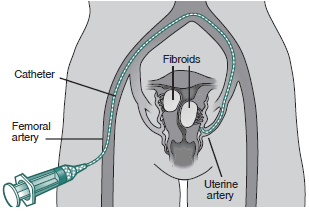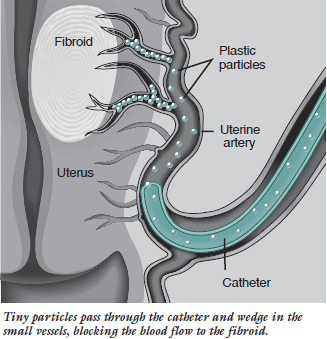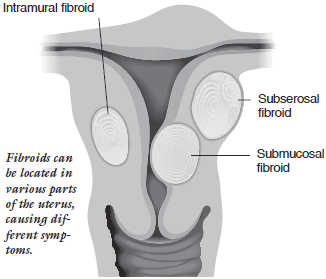What are uterine fibroids?
Fibroid tumors are noncancerous (benign) growths that develop in the muscular wall of the uterus. While fibroids do not always cause symptoms, their size and location can lead to problems for some women, including pain and heavy bleeding. They typically improve after menopause when the level of estrogen, the female hormone that circulates in the blood, decreases dramatically. However, menopausal women who are taking supplemental estrogen (hormone replacement therapy) may not experience relief of symptoms. Fibroids range in size from very tiny to the size of a cantaloupe or larger. In some cases they can cause the uterus to grow to the size of a five-month pregnancy or more. Fibroids may be located in various parts of the uterus.
There are three primary types of uterine fibroids:
- Subserosal fibroids, which develop in the outer portion of the uterus and expand outward. They typically do not affect a woman’s menstrual flow, but can become uncomfortable because of their size and the pressure they cause.
- Intramural fibroids, which develop within the uterine wall and expand, making the uterus feel larger than normal. These are the most common fibroids. This can result in heavier menstrual flows and pelvic pain or pressure.
- Submucosal fibroids are deep within the uterus, just under the lining of the uterine cavity. These are the least common fibroids, but they often cause symptoms, including very heavy and prolonged periods.
You might hear fibroids referred to by other names, including myoma, leiomyoma, leiomyomata and fibromyoma.
What are typical symptoms?
Depending on location, size and number of fibroids, they may cause:
- Heavy, prolonged menstrual periods and unusual monthly bleeding, sometimes with clots. This often leads to anemia.
- Pelvic pain
- Pelvic pressure or heaviness
- Pain in the back or legs
- Pain during sexual intercourse
- Bladder pressure leading to a constant urge to urinate
- Pressure on the bowel, leading to constipation and bloating
- Abnormally enlarged abdomen
Who is most likely to have uterine fibroids?
Uterine fibroids are very common, although often they are very small and cause no problems. From 20 to 40 percent of women age 35 and older have uterine fibroids of a significant size. African-American women are at higher risk for fibroids: as many as 50 percent have fibroids of a significant size.
How are uterine fibroids diagnosed?
Fibroids are usually diagnosed during a gynecologic internal examination. Your doctor will conduct a pelvic exam to feel if your uterus is enlarged. The presence of fibroids is most often confirmed by an abdominal ultrasound. Fibroids also can be confirmed using magnetic resonance (MR) and computed tomography (CT) imaging techniques. Ultrasound, MR and CT are painless diagnostic tests. Appropriate treatment depends on the size and location of the fibroids, as well as the severity of symptoms.
How are uterine fibroids treated?

Most fibroids do not cause symptoms and are not treated. When they do cause symptoms, drug therapy often is the first step in the treatment. This might include a prescription for birth-control pills or other hormonal therapy, or the use of non-steroidal anti-inflammatory drugs, such as ibuprofen or naproxen sodium. In many patients, symptoms are controlled with these treatments and no other therapy is required. Some hormone therapies do have side effects and other risks when used long-term so they are generally used temporarily. Fibroids often grow back after therapy is discontinued. The next step is to try more invasive therapy.
The most common treatment options include:
Uterine artery (or fibroid) embolization
An interventional radiologist makes a tiny incision in the groin and passes a small tube called a catheter through the artery. When the catheter reaches the uterine artery, the interventional radiologist slowly releases tiny plastic particles the size of grains of sand into the vessels. The particles flow to the fibroids first and wedge into the vessels and cannot travel to other parts of the body. This blocks the blood flow to the tumor, causing it to shrink.
Myomectomy
Myomectomy is a surgical procedure that removes visible fibroids from the uterine wall. Myomectomy, like UFE, leaves the uterus in place and may, therefore, preserve the woman’s ability to have children. There are several ways to perform myomectomy, including hysteroscopic myomectomy, laparoscopic myomectomy and abdominal myomectomy:
- Hysteroscopic Myomectomy: Hysteroscopic myomectomy is used only for fibroids that are just under the lining of the uterus and that protrude into the uterine cavity. There is no need for a surgical incision. The doctor inserts a flexible scope (hysteroscope) into the uterus through the vagina and cervix and removes the fibroids using special surgical tools fitted to the scope. Usually this is an outpatient procedure performed while the patient is under anesthesia and not conscious.
- Laparoscopic Myomectomy: Laparoscopic myomectomy may be used if the fibroid is on the outside of the uterus. Small incisions are made so the doctor can insert a probe with a tiny camera attached and another probe fitted with surgical instruments inside the abdominal cavity and remove the tumors. It is performed while the patient is under general anesthesia and not conscious. The average recovery time is about two weeks.
- Abdominal Myomectomy: This is a surgical procedure in which an incision is made in the abdomen to access the uterus, and another incision is made in the uterus to remove the tumor. Once the fibroids are removed, the uterus is stitched closed. The patient is given general anesthesia and is not conscious for this procedure, which requires a several-day hospital stay.
While myomectomy is frequently successful in controlling symptoms, the more fibroids there are in a patient’s uterus, generally, the less successful the surgery. In addition, fibroids may grow back several years after myomectomy.
Hysterectomy
Approximately one-third of the more than half-million hysterectomies performed in the United States each year are due to fibroids. In a hysterectomy, the uterus is removed in an open surgical procedure. This operation is considered major surgery and is performed while the patient is under general anesthesia. It requires three to four days of hospitalization and the average recovery period is about six weeks. Some women are candidates for a newer, laparoscopic procedure. The recovery time for this procedure is considerably shorter. Hysterectomy is the most common current therapy for women who have fibroids. It is typically performed in women who have completed their childbearing years or who understand that after the procedure, they cannot become pregnant.
What is fibroid embolization?

It is a minimally invasive procedure, which means it requires only a tiny nick in the skin. It is performed while the patient is conscious but sedated – drowsy and feeling no pain.
Fibroid embolization is performed by an interventional radiologist, a physician who is specially trained to perform this and other minimally invasive procedures. The interventional radiologist makes a small nick in the skin (less than 1⁄4 of an inch) in the groin and inserts a catheter into an artery. The catheter is guided through the artery to the uterus while the interventional radiologist watches the progress of the procedure using a moving X-ray (fluoroscopy). The interventional radiologist injects tiny plastic particles the size of grains of sand into the artery that is supplying blood to the fibroid tumor. This cuts off the blood flow and causes the tumor (or tumors) to shrink. The artery on the other side of the uterus is then treated.
Fibroid embolization usually requires a hospital stay of one night. Pain-killing medications and drugs that control swelling typically are prescribed following the procedure to treat cramping and pain, which are common side effects. Fever is an occasional side effect, and is usually treated with acetaminophen. Many women resume light activities in a few days and the majority of women are able to return to normal activities within one week.
While embolization to treat uterine fibroids has been performed since 1995, embolization of the uterus is not new. It has been used successfully by interventional radiologists for 20 years to treat heavy bleeding after childbirth. The procedure is now available at hospitals and medical centers across the country.
How successful is the fibroid embolization procedure?
Studies show that 78 to 94 percent of women who have the procedure experience significant or total relief of heavy bleeding, pain and other symptoms. The procedure also is effective for multiple fibroids. Recurrence of treated fibroids is very rare. In one study in which patients were followed for six years, no fibroid that had been embolized regrew.
Are there risks associated with the treatment of fibroid tumors?
Fibroid embolization is considered to be very safe, however, there are some associated risks, as there are with almost any medical procedure. Most women experience moderate to severe pain and cramping in the first several hours following the procedure. Some experience nausea and fever. These symptoms can be controlled with appropriate medications. A small number of patients have experienced infection, which usually can be controlled with antibiotics. It also has been reported that there is a 1 percent chance of injury to the uterus, potentially leading to hysterectomy. A small number of patients have entered into menopause after embolization. This is more likely to occur if the woman is in her mid-forties or older, and is already nearing menopause. Myomectomy and hysterectomy also carry risks, including infection and bleeding leading to transfusion. Patients who undergo myomectomy may develop adhesions causing tissue and organs in the abdomen to fuse together, which can lead to infertility. In addition, the recovery time is much longer for abdominal myomectomy, generally one to two months. You should talk with your doctor about possible side effects of any procedure you may choose.
Is fibroid embolization an FDA-approved procedure?
The FDA does not regulate the practice of medicine, but it does approve devices and medications. All devices, equipment and medications used for fibroid embolization are approved by the FDA for use in people. Many women wonder about the safety of leaving plastic particles in the body. It is reassuring to know that the particles most commonly used in UFE have been available with FDA approval for over 20 years. During that time, they have been used in thousands of patients without long-term complications.
List of facilities
Contact the following facilities only if your physician has confirmed that your symptoms are due to uterine fibroids.


